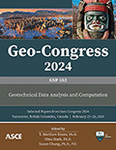Numerical Simulation of High-Speed Penetration of Munitions in Clay
Publication: Geo-Congress 2024
ABSTRACT
This study presents the findings of a 3D explicit finite element analysis exploring the effect of nose shape on the depth of burial (DoB) of projectiles in cohesive soil. Large deformation finite element (LDFE) analyses were performed using the commercial finite element code ABAQUS. Euler and Lagrange element interactions were captured using the coupled Eulerian-Lagrangian (CEL) algorithm. Ogive projectiles with various caliber radius heads (CRH), ranging from 9 to 11, dynamically impacted a clay target at an impact velocity of 200 m/s. A constitutive model comprising a Tresca soil model that accounted for strain softening and strain-rate dependency of shear strength through the Herschel-Bulkley model was employed. The results of the simulations were used to calibrate a phenomenological penetration model for predicting the depth of burial of projectiles in soils. The two fitting parameters of the phenomenological model were the drag coefficient C, and the bearing coefficient R, both of which were assumed to be constants. It was found that varying the ogive CRH within the ranges studied resulted in minimal change in the drag coefficient. Furthermore, the DoB was not significantly affected by these variations in the CRH. The bearing coefficient R was found to be constant for all ogives. It was concluded that the DoB was not sensitive to minor changes in the nose shape of ogive ordnances in clayey soils.
Get full access to this article
View all available purchase options and get full access to this chapter.
REFERENCES
Aubeny, C. P., and Shi, H. (2007). Effect of Rate-Dependent Soil Strength on Cylinders Penetrating Into Soft Clay. IEEE Journal of Oceanic Engineering, 32(1), 49–56. https://doi.org/10.1109/JOE.2007.890944.
Bless, S., Peden, B., Guzman, I., Omidvar, M., and Iskander, M. (2014). Poncelet Coefficients of Granular Media (pp. 373–380). https://doi.org/10.1007/978-3-319-00771-7_45.
Chow, S. H., and Airey, D. W. (2013). Soil strength characterisation using free-falling penetrometers. Géotechnique, 63(13), 1131–1143. https://doi.org/10.1680/geot.12.P.129.
Dassault Systemes Simulia. (2021). Abaqus 2021 Documentation.
Iskander, M., Bless, S., and Omidvar, S. (2015). Rapid Penetration Into Granular Media: visualizing the fundamental physics of rapid earth penetration. Elsevier.
Kim, Y. H., Hossain, M. S., and Wang, D. (2015). Effect of strain rate and strain softening on embedment depth of a torpedo anchor in clay. Ocean Engineering, 108, 704–715. https://doi.org/10.1016/j.oceaneng.2015.07.067.
Liu, H., Xu, K., and Zhao, Y. (2016). Numerical investigation on the penetration of gravity installed anchors by a coupled Eulerian–Lagrangian approach. Applied Ocean Research, 60, 94–108. https://doi.org/10.1016/j.apor.2016.09.002.
Liu, J., Pi, A., and Huang, F. (2015). Penetration performance of double-ogive-nose projectiles. International Journal of Impact Engineering, 84, 13–23. https://doi.org/10.1016/j.ijimpeng.2015.05.003.
Mana, D. S. K., Ghosh Dastider, A., Basu, P., and Chatterjee, S. (2018). In situ undrained shear strength characterization using data from free fall ball penetrometer tests. Computers and Geotechnics, 104, 310–320. https://doi.org/10.1016/j.compgeo.2017.12.006.
Nazem, M., Carter, J. P., Airey, D. W., and Chow, S. H. (2012). Dynamic analysis of a smooth penetrometer free-falling into uniform clay. Geotechnique, 62(10), 893–905. https://doi.org/10.1680/geot.10.P.055.
Omidvar, M., Bless, S., and Iskander, M. (2019). Recent Insights into Penetration of Sand and Similar Granular Materials (pp. 137–163). https://doi.org/10.1007/978-3-030-23002-9_5.
Omidvar, M., Iskander, M., and Bless, S. (2012). Stress-strain behavior of sand at high strain rates. International Journal of Impact Engineering, 49, 192–213. https://doi.org/10.1016/j.ijimpeng.2012.03.004.
Omidvar, M., Iskander, M., and Bless, S. (2014). Response of granular media to rapid penetration. International Journal of Impact Engineering, 66, 60–82. https://doi.org/10.1016/j.ijimpeng.2013.12.004.
Rosenberg, Z., Vayig, Y., Kositski, R., and Malka-Markovitz, A. (2020). More on the penetration of rigid projectiles in metallic targets. International Journal of Impact Engineering, 146, 103713. https://doi.org/10.1016/j.ijimpeng.2020.103713.
White, R. (2021). Large deformation explicit finite element simulations of high strain rate loading and rapid penetration of clay. Manhattan College.
White, R., Omidvar, M., Ads, A., Bless, S., and Iskander, M. (2023). Large Deformation Explicit Finite Element Simulations of Drop Tower Experiments on Clay (pp. 101–108). https://doi.org/10.1007/978-3-031-17453-7_15.
Young, C. W. (1969). Depth Prediction for Earth-Penetrating Projectiles. Journal of the Soil Mechanics and Foundations Division, 95(3), 803–817. https://doi.org/10.1061/JSFEAQ.0001285.
Zhou, H., and Randolph, M. F. (2007). Computational Techniques and Shear Band Development for Cylindrical and Spherical Penetrometers in Strain-Softening Clay. International Journal of Geomechanics, 7(4), 287–295. https://doi.org/10.1061/(ASCE)1532-3641(2007)7:4(287).
Information & Authors
Information
Published In
History
Published online: Feb 22, 2024
ASCE Technical Topics:
- Analysis (by type)
- Clays
- Construction engineering
- Construction management
- Engineering fundamentals
- Finite element method
- Geomechanics
- Geotechnical engineering
- Geotechnical investigation
- Methodology (by type)
- Models (by type)
- Numerical analysis
- Numerical methods
- Numerical models
- Penetration tests
- Project management
- Soil analysis
- Soil mechanics
- Soil properties
- Soils (by type)
- Three-dimensional analysis
Authors
Metrics & Citations
Metrics
Citations
Download citation
If you have the appropriate software installed, you can download article citation data to the citation manager of your choice. Simply select your manager software from the list below and click Download.
